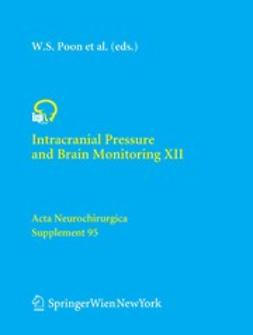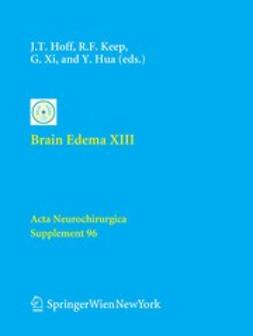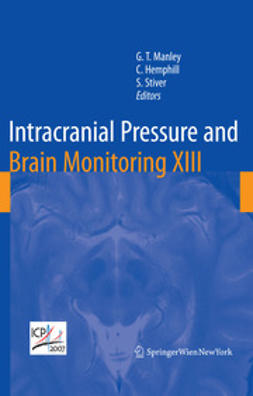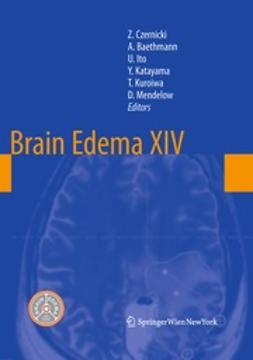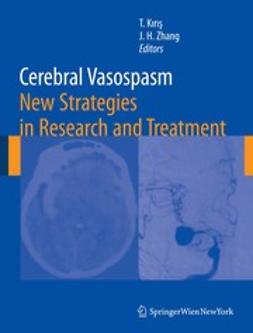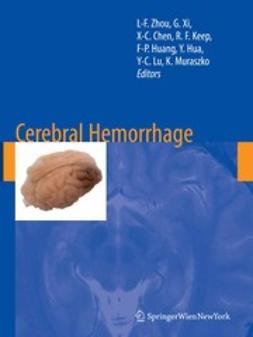Avezaat, Cees J. J.
Intracranial Pressure and Brain Monitoring XII
1. The importance of translational research in brain injury
A. Marmarou
2. Cerebral blood flow (CBF)-directed management of ventilated head-injured patients
W. S. Poon, S. C. P. Ng, M. T. V. Chan, J. M. K. Lam, W. W. M. Lam
3. Relationship of cerebral perfusion pressure levels to outcome in traumatic brain injury
C. J. Kirkness, R. L. Burr, K. C. Cain, D. W. Newell, P. H. Mitchell
4. Effects of moderate hyperventilation on cerebrovascular pressure-reactivity after head injury
L. A. Steiner, M. Balestreri, A. J. Johnston, J. P. Coles, D. A. Chatfield, J. D. Pickard, D. K. Menon, M. Czosnyka
5. Which paediatric head injured patients might benefit from decompression? Thresholds of ICP and CPP in the first six hours
I. R. Chambers, P. A. Jones, R. A. Minns, L. Stobbart, A. D. Mendelow, R. C. Tasker, F. Kirkham
6. Association between outcome, cerebral pressure reactivity and slow ICP waves following head injury
M. Balestreri, M. Czosnyka, L. A. Steiner, M. Hiler, E. A. Schmidt, B. Matta, D. Menon, P. Hutchinson, J. D. Pickard
7. Quantification of secondary CPP insult severity in paediatric head injured patients using a pressure-time index
P. A. Jones, I. R. Chambers, T. Y. M. Lo, P. J. D. Andrews, W. Chaudhry, A. Clark, J. Croft, R. Forsyth, B. Fulton, A. D. Mendelow, G. Wilson, R. A. Minns
8. The
P. Nilsson, I. Piper, G. Citerio, I. Chambers, C. Contant, P. Enblad, H. Fiddes, T. Howells, K. Kiening, Y. H. Yau
9. Accurate data collection for head injury monitoring studies: a data validation methodology
J. Barnes, I. Chambers, I. Piper, G. Citerio, C. Contant, P. Enblad, H. Fiddes, T. Howells, K. Kiening, P. Nilsson, Y. H. Yau
10. ICM+: software for on-line analysis of bedside monitoring data after severe head trauma
P. Smielewski, M. Czosnyka, L. Steiner, M. Belestri, S. Piechnik, J. D. Pickard
11. Survey of traumatic brain injury management in European
P. Nilsson, P. Enblad, I. Chambers, G. Citerio, H. Fiddes, T. Howells, K. Kiening, A. Ragauskas, J. Sahuquillo, Y. H. Yau, C. Contant, I. Piper
12. The importance of major extracranial injuries by the decompressive craniectomy in severe head injuries
U. Meier, A. Gräwe, A. König
13. Beneficial effect of cerebrolysin on moderate and severe head injury patients: result of a cohort study
G. K. C. Wong, X. L. Zhu, W. S. Poon
14. Re-defining the ischemic threshold for jugular venous oxygen saturation — a microdialysis study in patients with severe head injury
M. T. V. Chan, S. C. P. Ng, J. M. K. Lam, W. S. Poon, T. Gin
15. Estimated cerebral respiratory quotient and arteriovenous differences of CO
A. Chieregato, M. Marchi, C. Compagnone, V. Albarello, E. Fainardi, F. Tagliaferri, L. Targa
16. Linear correlation between stable intracranial pressure decrease and regional cerebral oxygenation improvement following mannitol administration in severe acute head injury patients
J. Gasco, J. Sendra, J. Lim, I. Ng
17. Brain tissue oxygen (P
M. Jaeger, M. Soehle, J. Meixensberger
18. Extracellular amino acid changes in patients during reversible cerebral ischaemia
R. Kett-White, M. T. O’Connell, P. J. A. Hutchinson, P. G. Al-Rawi, A. K. Gupta, J. D. Pickard, P. J. Kirkpatrick
19. Cerebral metabolism and intracranial hypertension in high grade aneurysmal subarachnoid haemorrhage patients
A. S. Sarrafzadeh, U. -W. Thomale, D. Haux, A. W. Unterberg
20. Effect of ischemic preconditioning on brain tissue gases and pH during temporary cerebral artery occlusion
M. T. V. Chan, R. Boet, S. C. P. Ng, W. S. Poon, T. Gin
21. Changes in cerebral hemodynamics and cerebral oxygenation during surgical evacuation for hypertensive intracerebral putaminal hemorrhage
I. Ng, E. Yap, J. Lim
22. Open lung ventilation in neurosurgery: an update on brain tissue oxygenation
S. Wolf, D. V. Plev, H. A. Trost, C. B. Lumenta
23. Magnesium sulfate for brain protection during temporary cerebral artery occlusion
M. T. V. Chan, R. Boet, S. C. P. Ng, W. S. Poon, T. Gin
24. Monitoring of autoregulation using intracerebral microdialysis in patients with severe head injury
M. T. V. Chan, S. C. P. Ng, J. M. K. Lam, W. S. Poon, T. Gin
25. Improvement of brain tissue oxygen and intracranial pressure during and after surgical decompression for diffuse brain oedema and space occupying infarction
M. Jaeger, M. Soehle, J. Meixensberger
26. Clinic investigation and logistic analysis of risk factors of recurrent hemorrhage after operation in the earlier period of cerebral hemorrhage
S. C. Chen, G. Feng
27. Cerebral blood flow augmentation in patients with severe subarachnoid haemorrhage
P. G. Al-Rawi, D. Zygun, M. Y. Tseng, P. J. A. Hutchinson, B. F. Matta, P. J. Kirkpatrick
28. Evidence for the importance of extracranial venous flow in patients with idiopathic intracranial hypertension (IIH)
N. Alperin, S. H. Lee, M. Mazda, S. G. Hushek, B. Roitberg, J. Goddwin, T. Lichtor
29. Subdural intracranial pressure, cerebral perfusion pressure, and degree of cerebral swelling in supra- and infratentorial space-occupying lesions in children
M. Stilling, E. Karatasi, M. Rasmussen, A. Tankisi, N. Juul, G. E. Cold
30. The role of noninvasive monitoring of cerebral electrical impedance in stroke
L. X. Liu, W. W. Dong, J. Wang, Q. Wu, W. He, Y. J. Jia
31. The effect of subarachnoid sodium nitroprusside on the prevention of vasospasm in subarachnoid haemorrhage
J. Pachl, P. Haninec, T. Tencer, P. Mizner, L. Houšt’ava, R. Tomáš, P. Waldauf
32. Mitochondrial injury measured by proton magnetic resonance spectroscopy in severe head trauma patients
A. Marmarou, S. Signoretti, P. Fatouros, G. A. Aygok, R. Bullock
33. Cerebral blood flow in mean cerebral artery low density areas is not always ischemic in patients with aneurysmal subarachnoid hemorrhage — relationship with neurological outcome
A. Chieregato, F. Tagliaferri, A. Tanfani, F. Cocciolo, W. Benedettini, C. Compagnone, M. Ravaldini, R. Pascarella, R. Battaglia, M. Frattarelli, L. Targa, E. Fainardi
34. Cerebral blood flow mapping in two different subtypes of intraparenchymal hemorrhagic traumatic lesions
A. Chieregato, C. Compagnone, A. Tanfani, M. Ravaldini, F. Tagliaferri, R. Pascarella, F. Servadei, L. Targa, E. Fainardi
35. Glucose metabolism in traumatic brain injury: a combined microdialysis and [
M. T. O’Connell, A. Seal, J. Nortje, P. G. Al-Rawi, J. P. Coles, T. D. Fryer, D. K. Menon, J. D. Pickard, P. J. Hutchinson
36. Postoperative changes in SPECT-rCBF in hydrocephalus
S. K. Piechnik, L. Hultin
37. Dynamic susceptibility contrast-enhanced perfusion MR imaging in late radiation-induced injury of the brain
Y. L. Chan, D. K. W. Yeung, S. F. Leung, S. F. Lee, A. S. C. Ching
38. MRI study of cerebral blood flow and CSF flow dynamics in an upright posture: the effect of posture on the intracranial compliance and pressure
N. Alperin, S. G. Hushek, S. H. Lee, A. Sivaramakrishnan, T. Lichtor
39. Quantitative evaluation of cerebrovascular reactivity in brain tissue by a refill kinetic method of transcranial ultrasonic perfusion imaging: a comparison with Doppler sonography
T. Shiogai, A. Morisaka, N. Takayasu, K. Yoshikawa, T. Mizuno, M. Nakagawa, H. Furuhata
40. Relationship between total cerebral blood flow and ICP measured noninvasively with dynamic MRI technique in healthy subjects
N. Alperin, S. H. Lee, A. Sivaramakrishnan, T. Lichtor
41. Clinical comparison of tympanic membrane displacement with invasive ICP measurements
S. Shimbles, C. Dodd, K. Banister, A. D. Mendelow, I. R. Chambers
42. Gravity valves for idiopathic normal-pressure hydrocephalus: a prospective study with 60 patients
U. Meier
43. The relationship between CSF circulation and cerebrovascular pressure-reactivity in normal pressure hydrocephalus
Z. Czosnyka, F. Boogaard, M. Czosnyka, S. Momjian, L. Gelling, J. D. Pickard
44. Evolution of intracranial pressure during the immediate postoperative period after endoscopic third ventriculostomy
D. Santamarta, J. Martin-Vallejo
45. Clinical research on monitoring CSFP through lumbar epidural pressure
Z. Liu, Y. Y. Dou, R. Chen, X. Z. Zhang
46. Evaluation of three new models of hydrocephalus shunts
Z. H. Czosnyka, M. Czosnyka, H. K. Richards, J. D. Pickard
47. The enigma of underdrainage in shunting with hydrostatic valves and possible solutions
C. Sprung, C. Miethke, H. -G. Schlosser, M. Brock
48. Guidelines for management of idiopathic normal pressure hydrocephalus: progress to date
A. Marmarou, P. Black, M. Bergsneider, P. Klinge, N. Relkin
49. Three-year outcome of shunted idiopathic NPH patients
G. Aygok, A. Marmarou, H. F. Young
50. Clinical testing of CSF circulation in hydrocephalus
Z. Czosnyka, M. Czosnyka, B. Owler, S. Momjian, M. Kasprowicz, E. A. Schmidt, P. Smielewski, J. D. Pickard
51. Intracranial baroreflex yielding an early Cushing response in human
E. A. Schmidt, Z. Czosnyka, S. Momjian, M. Czosnyka, R. A. Bech, J. D. Pickard1
52. Does the ventricle size change after shunt operation of normal-pressure hydrocephalus?
U. Meier, S. Mutze
53. Intravenous magnesium sulfate to improve outcome after aneurysmal subarachnoid hemorrhage: interim report from a pilot study
R. Boet, M. T. V. Chan, W. S. Poon, G. K. C. Wong, H. T. Wong, T. Gin
54. Secondary insults and outcomes in patients with hypertensive basal ganglia hemorrhage
Z. Fei, X. Zhang, S. J. Song
55. Balance of risk of therapeutic hypothermia
S. Hayashi, M. Takayasu, S. Inao, J. Yoshida
56. The influence of mild hypothermia on ICP, CPP and outcome in patients with primary and secondary brain injury
M. Smrcka, M. Vidlák, K. Máca, V. Smrcka, R. Gál
57. Contribution of raised ICP and hypotension to CPP reduction in severe brain injury: correlation to outcome
A. Marmarou, A. Saad, G. Aygok, M. Rigsbee
58. Mortality from traumatic brain injury
J. Lu, A. Marmarou, S. Choi, A. Maas, G. Murray, E. W. Steyerberg
59. Assessment of different data representations and averaging methods on the Spiegelberg compliance device
Y. H. Yau, I. R. Piper, C. Contant, L. Dunn, I. R. Whittle
60. Assessment of the relationship between age and continuous intracranial compliance
K. L. Kiening, W. Schoening, A. W. Unterberg, J. F. Stover, G. Citerio, P. Enblad, P. Nilsson
61. Cerebral haemodynamic assessment in patients with thalamic haemorrhage: a pilot study with continuous compliance monitoring
S. C. P. Ng, W. S. Poon, M. T. V. Chan
62. Non-invasive measurement of intracranial compliance using cine MRI in normal pressure hydrocephalus
M. Mase, T. Miyati, K. Yamada, H. Kasai, M. Hara, Y. Shibamoto
63. Pulse and mean intracranial pressure analysis in pediatric traumatic brain injury
M. Aboy, J. McNames, W. Wakeland, B. Goldstein
64. Preliminary report on spiegelberg pre and post-operative monitoring of severe head-injured patients who received decompressive craniectomy
J. Abdullah, I. Zamzuri, S. Awang, S. Sayuthi, A. Ghani, A. Tahir, N. N. Naing
65. Age-dependence of cerebrospinal parameters
K. König, H. E. Heissler, M. Zumkeller, E. Rickels
66. A computer model of intracranial pressure dynamics during traumatic brain injury that explicitly models fluid flows and volumes
W. Wakeland, B. Goldstein
67. Plateau waves: changes of cerebrovascular pressure transmission
M. L. Daley, C. W. Leffler, M. Czosnyka, J. D. Pickard
68. Brain tissue biomechanics in cortical contusion injury: a finite element analysis
A. Peña, J. D. Pickard, D. Stiller, N. G. Harris, M. U. Schuhmann
69. Modifications of spontaneous cerebral blood flow oscillations during cardiopulmonary bypass
J. Nicolet, T. Gillard, G. Gindre, F. Cervenansky, C. Duale, J. E. Bazin, C. Riberolles, P. Schoeffler, J. J. Lemaire
70. Concept of “true ICP” in monitoring and prognostication in head trauma
M. Czosnyka, L. Steiner, M. Balestreri, E. Schmidt, P. Smielewski, P. J. Hutchinson, J. D. Pickard
71. Fuzzy pattern classification of hemodynamic data can be used to determine noninvasive intracranial pressure
B. Schmidt, S. F. Bocklisch, M. Päßler, M. Czosnyka, J. J. Schwarze, J. Klingelhöfer
72. Clinical experience with the noninvasive ICP monitoring system
Y. L. Zhao, J. Y. Zhou, G. H. Zhu
73. Innovative non-invasive method for absolute intracranial pressure measurement without calibration
A. Ragauskas, G. Daubaris, A. Dziugys, V. Azelis, V. Gedrimas
74. The correlation of midline shifts of human brain with large brain haematoma using a finite element approach
A. Y. S. Cheng, M. C. Y. Pau, W. S. Poon, G. K. C. Wong
75. Clinical study of continuous non-invasive cerebrovascular autoregulation monitoring in neurosurgical ICU
A. Ragauskas, G. Daubaris, V. Petkus, V. Ragaisis, M. Ursino
76. Increased intracranial pressure induces a rapid systemic interleukin-10 release through activation of the sympathetic nervous system
C. Woiciechowsky, H. -D. Volk
77. Experimental model for investigating hyponatremia after subarachnoid hemorrhage in rats
T. Mori, Y. Katayama, J. Kojima, N. Moro, H. Kawai, M. Yoneko, T. Kawamata
78. Effects of venom defibrase on brain edema after intracerebral hemorrhage in rats
G. Wu, F. P. Huang
79. Complement inhibition attenuates brain edema and neurological deficits induced by thrombin
Y. Gong, G. H. Xi, R. F. Keep, J. T. Hoff, Y. Hua
80. Reduction of neural and vascular damage by transplantation of VEGF-secreting neural stem cells after cerebral ischemia
W. Zhu, Y. Mao, L. F. Zhou
81. Ischemia-induced endothelial cell dysfunction
R. F. Keep, A. V. Andjelkovic, S. M. Stamatovic, P. Shakui, S. R. Ennis
82. Systemic use of argatroban reduces tumor mass, attenuates neurological deficits and prolongs survival time in rat glioma models
Y. Hua, L. L. Tang, M. E. Fewel, R. F. Keep, T. Schallert, K. M. Muraszko, J. T. Hoff, G. H. Xi
83. Spinal contribution to CSF pressure lowering effect of mannitol in cats
M. Klarica, R. Varda, M. Vukic, D. Oreškovic, M. Radoš, M. Bulat
84. Cell column chromatography: a new research tool to quantify cerebral cell volume changes following chemically-induced anoxia/re-oxygenation
F. Xiao, S. Pardue, T. Nash, T. C. Arnold, J. S. Alexander, D. L. Carden, R. Turnage, A. Jawahar, S. A. Conrad
85. Ifenprodil treatment is associated with a down-regulation of brain aquaporin 4 following cardiac arrest in rats
F. Xiao, S. Pardue, T. C. Arnold, J. Monroe, J. S. Alexander, D. L. Carden, R. Turnage, S. A. Conrad
86. Intracerebral hemorrhage induces edema and oxidative stress and alters N-methyl-D-aspartate receptor subunits expression
T. Nakamura, R. F. Keep, Y. Hua, J. W. Park, T. Itano, S. Nagao, J. T. Hoff, G. H. Xi
87. Aging enhances intracerebral hemorrhage-induced brain injury in rats
Y. Gong, G. H. Xi, R. F. Keep, J. T. Hoff, Y. Hua
88. The antioxidant effect of N-acethylcysteine on experimental contusion in rats
U. -W. Thomale, M. Griebenow, S. -N. Kroppenstedt, A. W. Unterberg, J. F. Stover
89. The investigation of cerebrospinal fluid formation by ventriculo-aqueductal perfusion method in cats
D. Oreškovic, M. Vukic, M. Klarica, M. Bulat
90. Introduction for the neurochemical satellite symposium
P. J. Hutchinson, W. S. Poon
91. Microdialysis in traumatic brain injury — methodology and pathophysiology
P. J. Hutchinson
92. Brain tissue oxygenation monitoring in acute brain injury
I. Ng, K. K. Lee, J. Wong
93. Near infrared spectroscopy in brain injury: today’s perspective
P. G. Al-Rawi
94. Imaging of cerebral blood flow and metabolism in brain injury in the ICU
J. D. Pickard, P. J. Hutchinson, J. P. Coles, L. A. Steiner, A. J. Johnston, T. D. Fryer, M. R. Coleman, P. Smielewski, D. A. Chatfield, F. Aigbirhio, G. B. Williams, K. Rice, J. C. Clark, C. H. Salmond, B. J. Sahakian, P. G. Bradley, T. A. Carpenter, R. Salvador, A. Pena, J. H. Gillard, A. S. Cunningham, S. Piechnik, M. Czosnyka, D. K. Menon
95. Brain injury and proteomics/peptidomics: is it relevant? An overview
M. U. Schuhmann, G. Heine, M. Skardelly, M. Jaeger, H. Selle
96. Circulating nucleic acid analysis: diagnostic applications for acute pathologies
R. W. K. Chiu, T. H. Rainer, Y. M. D. Lo
97. The Lund concept: is this logical?
C. -H. Nordström
DRM-restrictions
Printing: not available
Clipboard copying: not available
Keywords: MEDICAL / Public Health MED078000
- Author(s)
- Avezaat, Cees J. J.
- Chan, Matthew T. V.
- Czosnyka, Marek
- Goh, Keith Y. C.
- Hutchinson, Peter J. A.
- Katayama, Yoichi
- Lam, Joseph M. K.
- Marmarou, Anthony
- Ng, Stephanie C. P.
- Pickard, John D.
- Poon, Wai S.
- Publisher
- Springer
- Publication year
- 2005
- Language
- en
- Edition
- 1
- Category
- Medicine, Health Care, Mode
- Format
- Ebook
- eISBN (PDF)
- 9783211323182

